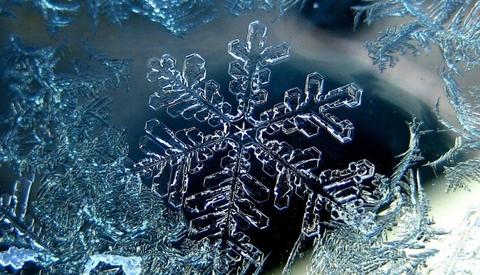
To many people, snow is just snow. If you take a closer look, there are different types of snow crystals.
The predominant factor in what shape it forms is temperature, but a lot happens from when a snowflake forms and hits the ground. They can collide, melt, combine with water droplets, and pass through different temperature variations in the atmosphere.
All of this affects the final nature of the snow as it hits the ground on your premises. All snow and ice is slippery and presents a slip and fall hazard. The question is, should your facility maintenance plan include the fine details on the main types of snow crystals and the impact on the effectiveness of your plan?
Snow crystals can take the form of plates, needles, columns, dendrites, crystals, sector plates, and bullets. There are many variations in between which scientists have studied in extensive detail. All take on a similar six-sided hexagonal shape. Below are descriptions of the major types.
Dendrites
While this is the common formation people think of with snowflakes, they only form in temperatures from 3 ̊F to 10 ̊F. These can take on a tree-like formation with branches and can range up to four millimeters across. Other dendrites have a fern-like appearance and tend to be around five millimeters or more across. A powdery, low-density snowpack typically results when these accumulate in large numbers, making for easier shoveling, blowing, and melting.
Columns
Snow flakes can take the form of hollow, hexagonal columns. These are quite small and hard to see and there are conical shaped hollow sections at each end. These form at around 14 ̊F to 21 ̊F. In temperatures below -8 ̊F, plates grow on the ends as the columns fall into warmer air layers.They can be more densely packed yielding thickly packed snow.
Needles
Needles proliferate in temperatures from 21 ̊F to 25 ̊F. They appear as solid hair-like columns and transform from other varieties of snow flakes with just subtle temperature changes.
Plates
Thin plated crystals are most often seen when it’s around 25 ̊F to 32 ̊F. They form in much colder temperatures higher up in the atmosphere. A star like shape is flattened into a plate-like appearance. Steller plates have a star-like shape with six broad arms, while double plates and split plates are other varieties.
Sector Plates
Found in temperatures from 10 ̊F to 14 ̊F, sector plates have characteristic ridges and prism facets. The ridges can be broad and prominent.
Crystals
Snow can be made up of triangular crystals; the three-fold shape can sometimes sprout arms which is a rare format. Rimed crystals form when water droplets hit the crystal and freeze, sort of decorating the crystal. The frozen droplets can accumulate so much it takes on a snowball effect, creating a type of snow called graupel. Irregular crystal shapes are very common, as it’s easy for frozen precipitation to collide and stick together.
Bullets
Ice crystals sometimes form bullet shapes, especially if they grow together at different angles.These can form columns, radiating outward from one another, creating a bullet rosette.
Your maintenance crew will most likely not take notice of what shape the snow flakes are. The main impact is how difficult it is to remove snow. Temperature, timing, staff, and removal method are factors impacting how your plan works. The colder it is, the less likely any snow and ice will melt on its own. If you do take note of dendrites, plates, needles, and columns, most likely you’ll need to take more action as the temperatures need to be bitterly cold.
Written by: Hillel Glazer is an expert in the field of radiant snow melting and serves as the President and CEO of HeatTrak. He has helped hundreds of safety and maintenance professionals design portable snow melting systems for their facilities. He has been featured in The New York Times, The Wall Street Journal and on Fox, NBC and The Weather Channel. Connect with him on LinkedIn.


